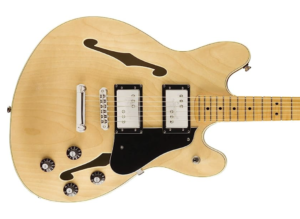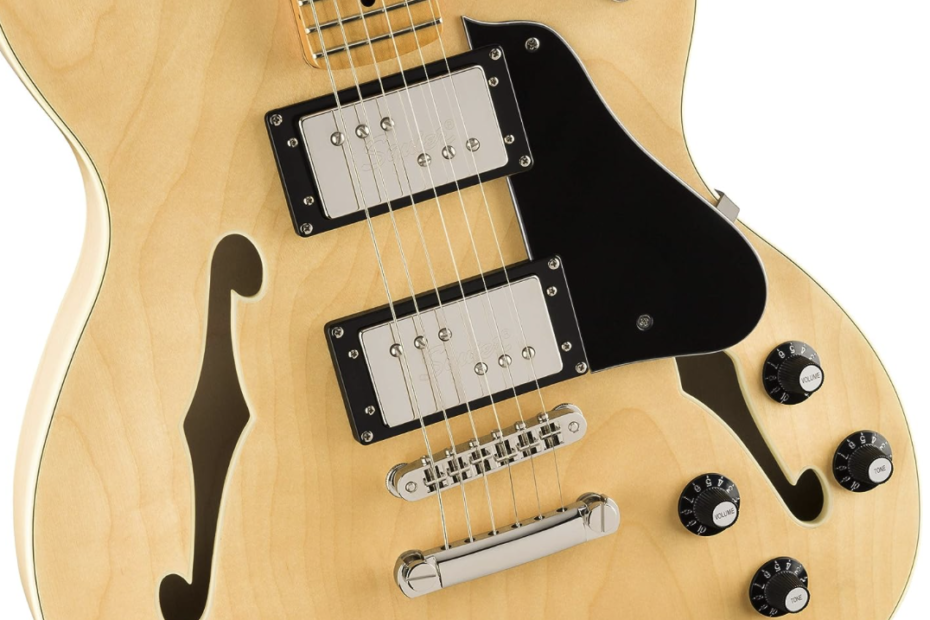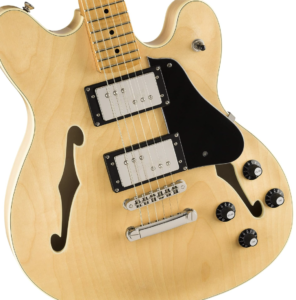The Fender Starcaster holds a special place in the hearts of guitar enthusiasts as a guitar that has gone through a fascinating journey in the world of music.
Originally introduced in the 1970s, the Fender electric guitar Starcaster was designed to be a semi-hollowbody guitar, offering players a unique tonal character and a distinctive look. Over the years, this model has seen various iterations, and in recent times, Fender decided to reintroduce the Starcaster to the delight of guitar players seeking something extraordinary.
 Origins of the Starcaster
Origins of the Starcaster
In 1976, Fender sought to diversify its product line and launched the Starcaster to cater to players looking for a semi-hollowbody guitar. Unlike Fender’s traditional solid-body guitars, the Starcaster featured a semi-hollow construction with a center block to reduce feedback while retaining some of the warm resonance of hollowbody guitars. Its unique body shape, reminiscent of classic archtops, gave it a vintage aesthetic appeal.
The Starcaster was initially offered as an electric guitar and a bass guitar, both sporting the semi-hollow design. Although the original Starcaster guitars were short-lived and discontinued in the late 1970s, they gained a cult following over the years due to their rarity and unique sound.
Revival of the Starcaster
In recent years, vintage instruments have seen a resurgence in popularity, and the Fender Starcaster was no exception. Drawing inspiration from the original design, Fender reissued the Starcaster, but this time as part of their Modern Player series in 2013. The modern Starcaster kept the semi-hollowbody construction but included some contemporary upgrades.
The reissued Starcaster featured a 3-ply maple body with an f-hole, a C-shaped maple neck with a 22-fret rosewood fingerboard, and a pair of Fender Wide Range humbucking pickups. The guitar also had a vintage-style floating bridge with a tailpiece, and a 6-saddle adjustable bridge for precise intonation.
Guitar Paint: Enhancing and Protecting Your Instrument
Mexican Guitar: The Enchanting Sound of the Guitarron
Guitar Wireless System: Unleashing Freedom
The 8-String Guitar: Expanding Your Possibilities
Unique Sound and Versatility
The Starcaster’s semi-hollow design gives it a unique tonal characteristic, combining the warm, woody tones of a hollowbody guitar with the sustain and clarity of a solid-body guitar. The Fender Wide Range humbucking pickups add to the guitar’s versatility, offering players a wide range of tonal options suitable for various musical styles.
Whether you’re playing jazz, blues, rock, or indie music, the Starcaster can deliver the goods. Its airy, resonant sound with a well-defined attack makes it stand out in a mix, making it an attractive choice for studio recordings and live performances alike.
 Modern Interpretations
Modern Interpretations
In addition to the Modern Player series reissue, Fender has also introduced other variations of the Starcaster. The Parallel Universe series, known for its imaginative take on classic Fender models, showcased the Starcaster in a limited-edition, high-end version with stunning finishes and premium features.
Additionally, Fender has also released more affordable versions of the Starcaster as part of their Squier line, making this iconic design accessible to a broader audience.
Features of the Starcaster
The Fender Starcaster, whether in its original vintage models or the modern reissues, comes with a set of distinct features that set it apart from other Fender guitars. Here are some key features of the Fender Starcaster:
- Semi-Hollowbody Design: The Starcaster features a semi-hollowbody construction with a center block running through the body. This design reduces feedback while providing a warm, resonant tone similar to traditional hollowbody guitars.
- Archtop-inspired Body: The Starcaster sports an archtop-inspired body shape, reminiscent of classic jazz guitars. This unique design contributes to its vintage aesthetic and adds to the instrument’s visual appeal.
- F-Hole: Like traditional archtop guitars, the Starcaster features an f-hole on the top, which enhances its acoustic projection and adds to its classic appearance.
- Wide Range Humbucking Pickups: Most Starcaster models come equipped with Fender Wide Range humbucking pickups. These pickups offer a unique and versatile tonal palette, blending the warmth of humbuckers with the clarity of single-coils.
- 3-Ply Maple Body: The body of the Starcaster is typically constructed from 3-ply maple, which contributes to its resonant and vibrant tone.
- C-shaped Maple Neck: The guitar often boasts a comfortable C-shaped maple neck, providing a smooth playing experience and facilitating easy access to higher frets.
- Rosewood Fingerboard: The fingerboard is usually made from rosewood, offering a warm and smooth playing surface.
- Floating Bridge and Tailpiece: The Starcaster typically features a vintage-style floating bridge and tailpiece, allowing for some control over the guitar’s intonation and sustain.
- Unique Control Layout: The control layout of the Starcaster is slightly different from other Fender models. It typically includes individual volume and tone controls for each pickup, as well as a three-way pickup selector switch.
- Vintage-inspired Finishes: Both vintage and modern Starcaster models often come in a variety of classic and eye-catching finishes, appealing to players who appreciate vintage aesthetics.
- Modern Reissues and Limited Editions: Fender has released various reissues and limited-edition versions of the Starcaster, offering players a chance to own a modern interpretation of this iconic guitar with contemporary improvements and premium features.
Electronics of the Starcaster
 The electronics of the Fender Starcaster play a crucial role in shaping its unique and versatile tone. As with most electric guitars, the Starcaster’s electronics consist of pickups, controls, and wiring, all working together to deliver the guitar’s sound. Here’s a closer look at the electronics of the Starcaster:
The electronics of the Fender Starcaster play a crucial role in shaping its unique and versatile tone. As with most electric guitars, the Starcaster’s electronics consist of pickups, controls, and wiring, all working together to deliver the guitar’s sound. Here’s a closer look at the electronics of the Starcaster:
- Pickups: The Starcaster typically features Fender Wide Range humbucking pickups. These pickups were originally introduced in the 1970s and are known for their distinctive sound. The Wide Range humbuckers are not your standard humbuckers; they offer a more single-coil-like clarity with a touch of vintage warmth. These pickups have adjustable pole pieces, allowing players to fine-tune the balance between the strings for better tonal consistency.
- Control Layout: The Starcaster’s control layout is similar to many other electric guitars but with a unique configuration. It usually includes two individual volume controls, one for each pickup, which allows you to blend the two pickups to find your preferred balance. There are also two individual tone controls for each pickup, providing further tonal shaping capabilities.
- Pickup Selector Switch: The Starcaster comes equipped with a three-way pickup selector switch. This switch allows you to choose between the neck, bridge, or a combination of both pickups, giving you access to a range of different tones.
- Wiring: The Starcaster’s internal wiring is designed to minimize interference and noise while maximizing the pickups’ output. The wiring and components used in the electronics play a significant role in the guitar’s overall tonal characteristics.
- Output Jack: The output jack is where you connect your instrument cable to the guitar. It transfers the guitar’s signal to your amplifier or other audio equipment. It’s essential to ensure that the output jack is securely connected to avoid any unwanted signal loss or noise.
The combination of the unique Wide Range humbuckers and the versatile control layout provides players with a broad sonic palette to explore. The Starcaster’s electronics contribute to its distinct voice, making it a fantastic choice for various musical styles, from jazz and blues to rock and beyond.
Conclusion
The Fender Starcaster remains a guitar that embodies the spirit of innovation and experimentation that Fender is known for. With its semi-hollowbody construction, unique tonal character, and vintage appeal, the Starcaster has found a new generation of players eager to explore its distinct sound.

